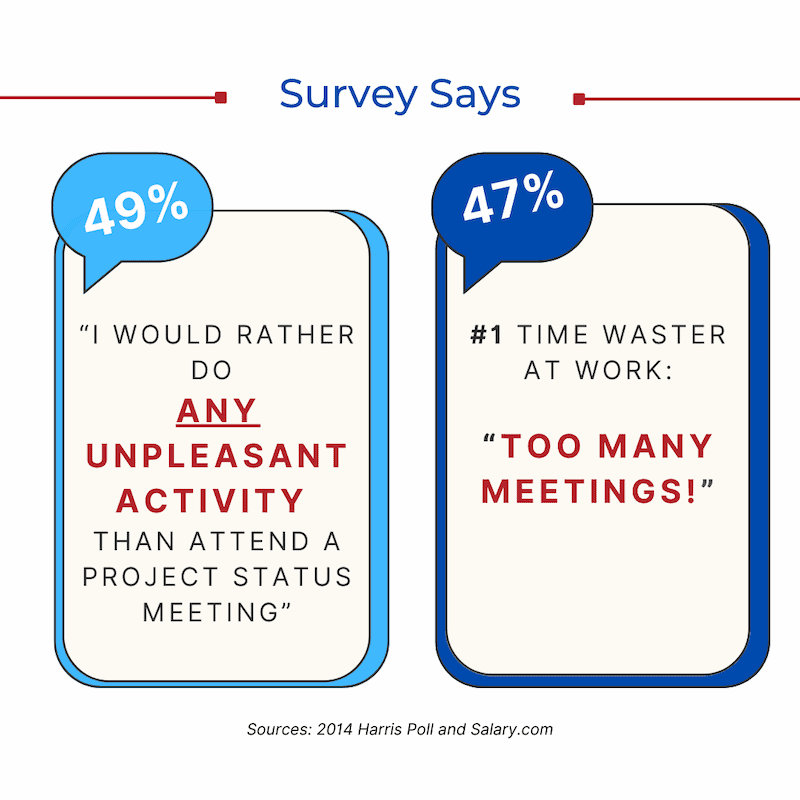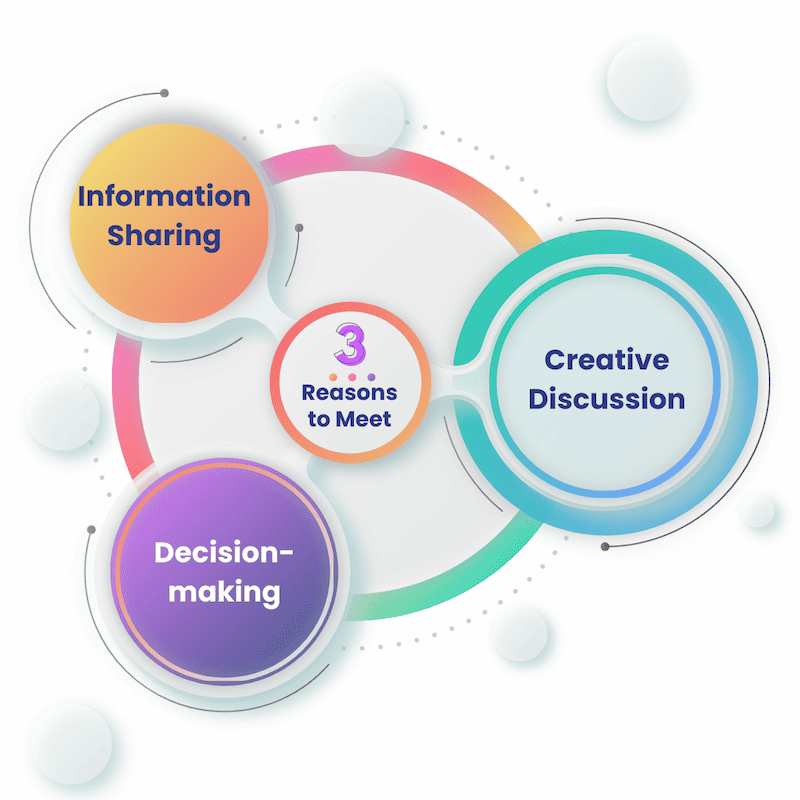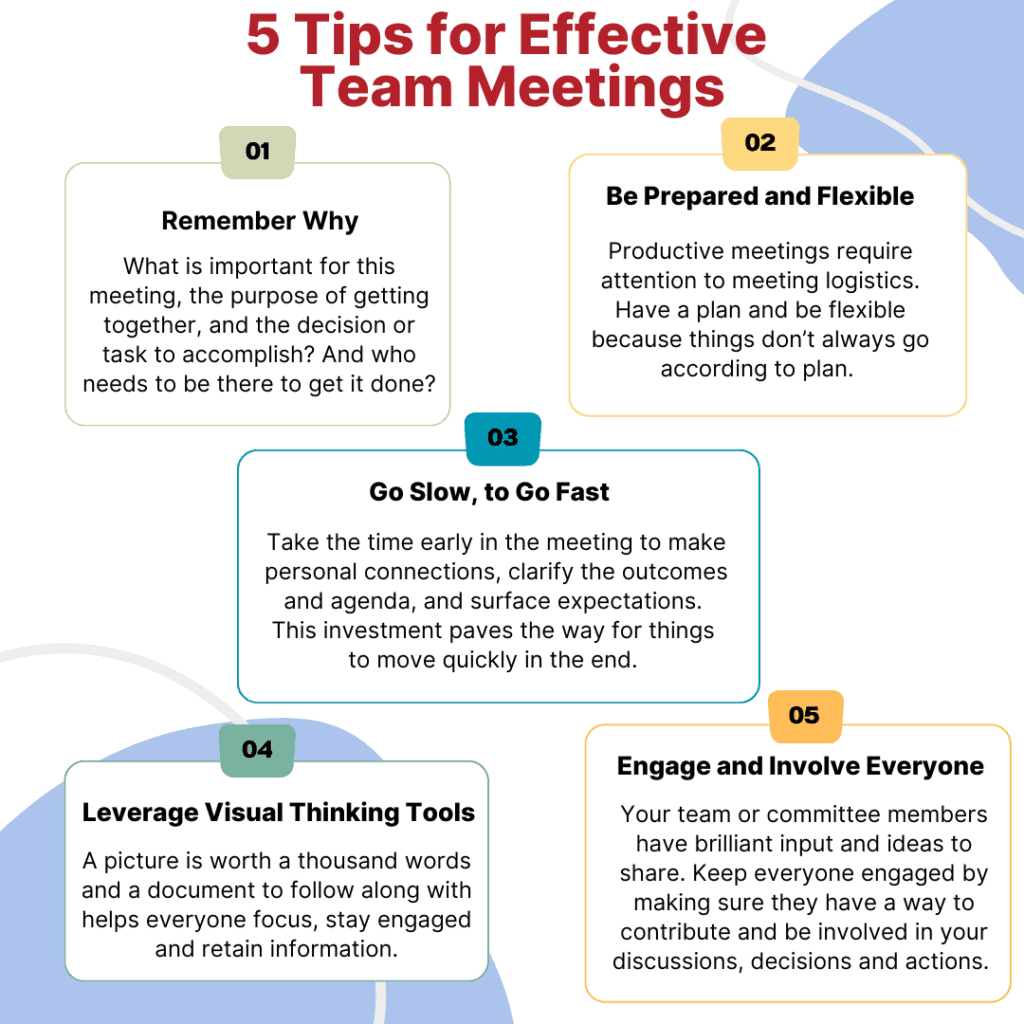How to Lead Effective Team or Committee Meetings
Love or hate them, meetings are inescapable if you work on a team or committee. But you don’t need to have the negative experiences that almost half the respondents in recent surveys shared about their meetings.
How to Lead More Effective Meetings (the struggle is real)

We spend a lot of time with teams who want to make their meetings more effective.
When we ask what’s giving them grief, invariably, we hear any combination of these things come up repeatedly.
- Lack of clarity around why and what they should be meeting about
- No structure to guide the design and delivery of their meeting
- Confusion around decision-making
One of the often overlooked facts about team or committee work is that we form teams to advance our goals. Teams that don’t have the means to quantify and track progress on meeting those goals find themselves challenged, frustrated, and feeling ineffective. The impacts are turnover and lost productivity. Who needs that?
Want more effective meetings? Two tips you can action now
If you’re wondering how to lead effective team or committee meetings, we’ve got two tips you can action immediately:
- Structure with a Weekly Action Review Meeting
- Set Expectations
1. Structure with a Weekly Action Review Meeting
We’ve found one of the more effective remedies to the grief that teams express around meetings is to help them structure a Weekly Action Review meeting.
Weekly Action Review meetings help a team:
- Hold each other accountable to commitments
- Track progress
- Identify and make decisions on how to resolve emerging work challenges
- Share experience and lessons learned on challenging situations team members have navigated.
To this end, the Weekly Action Review meeting should include three basic elements:
- Information sharing
- Creative discussions
- Decision-making.

Each of these items is described briefly below.
1Information Sharing
Information sharing is typically a one-way discussion: questions for clarification are welcomed, while discussion and debate are avoided. The objective here is to be short and to the point and have everyone actively listen.
Time is allocated for each team member to share three things:
- Since our last meeting, I accomplished …
- Until our next meeting, I’m working on …
- Here’s what’s getting in my way or keeping me from doing my job …
The focus here is on capturing key points from each person.
A strict use of time is applied here, giving each team member the same amount of time to share information. Recognize if you’ve got six people on a team, giving everyone five minutes takes 30 minutes of meeting time.
2Creative Discussion
Creative discussion is about exploring challenges and opportunities and solving the problems associated with getting important work done. This part of the meeting is much more interactive and requires creative thinking and problem solving.
Here, the team focuses on exploring the challenges raised in the information-sharing portion of the meeting and on generating, developing, and implementing ideas to resolve them. In this part of the agenda, team members can also share lessons learned from their work experience.
This activity builds knowledge and allows the team to assess how to integrate key learnings into their day-to-day work.
3Clarify Decision Making
During the decision-making portion of the meeting, time is allocated to decisions that need to be made to advance goals.
Have you ever wondered why some teams excel through decisions and some get completely paralyzed by them?
It’s important to clarify who the decision-maker is and how decisions will be made. Will decisions be made by the team lead or a more senior manager, or will the team make decisions through consensus? Different situations may require different approaches to decision-making. Having clarity before the decisions are made is critical to a well functioning team.
Decision-making is a privilege that carries responsibility. And making effective decisions relies on the availability of relevant information. If the meeting requires decision-making, you may ask team members to prepare by reviewing documentation or performing other tasks.
2. Set Expectations
1Use an Agenda
Regardless of whether you are planning a Weekly Action Review meeting or another type of meeting, an agenda is needed. An agenda is meant to answer four critical questions for participants:
- Why are we meeting?
- What will we be doing?
- How will we be doing it?
- And if I attend, what’s in it for me?
An agenda also helps you:
- Home in on who needs to participate
- Communicate how you’ll make good use of everyone’s time, how they can contribute, and what they need to do to prepare
- Increase engagement
- Give people the opportunity to opt in or out
- Allocate and manage time for each agenda item
2Capture Decisions, Action Items and Next Steps
Be sure to allocate time to capture decisions, action items and next steps so that everyone leaves the meeting clear on their responsibilities to the team. And make sure everyone understands they’re accountable for reporting on these in the next meeting.
3 Make the Meeting Experience a Priority

Once you’ve structured your Weekly Action Review meeting and set expectations for effectiveness, the next place to look to improve the efficacy is in the meeting experience. This means spending time to optimize engagement and build relationships and trust. It also means examining how the meeting went and purposely working to improve.
As you start your meeting, remind participants why the meeting is essential, and what you’d like to achieve. Take the time to make personal connections, clarify outcomes, and surface expectations for participants. Whether you’re meeting online or in-person, visual thinking tools and documentation help to keep everyone engaged and to help retain information.
And finally, as each meeting ends, spending a few minutes to review the meeting process and experience will go a long way to supporting continuous improvement. At a minimum, ask what’s working well and what isn’t working so well, and decide how you will work together to make the next meeting better.
Team and committee meetings aren’t effective through wishful thinking. It takes deliberate action to establish the purpose and structure of your meeting to bring clarity to decision-making and maximize participation.
Need help with making your meetings more effective?
If your team or committee is grieving their meeting experience, we offer customized training, tools, templates and coaching to improve your team’s effectiveness. A meeting audit—where we observe the structure and process of your meeting—results in actionable advice, tools and templates to help you go farther and faster in your efforts to improve.


